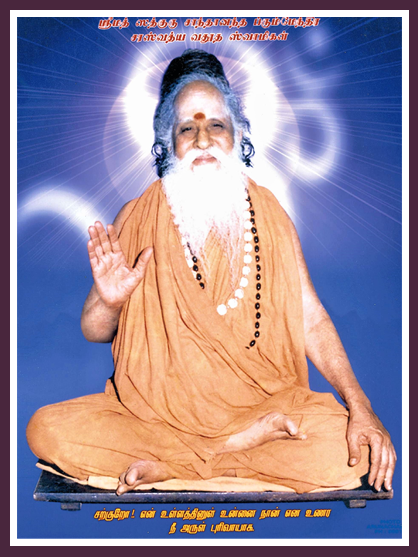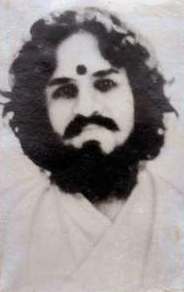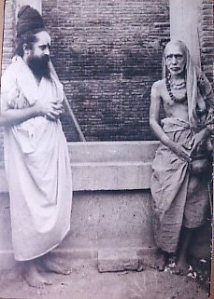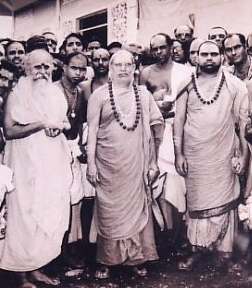
Swamiji’s Life History
God manifests himself once in many centuries to protect the righteous, to destroy the wicked and to establish dharma firmly. In between, very often. He causes the birth of noble souls to propagate righteousness. These are the saints; the saviors of society; the salt of the earth. Most of these messengers of God did not have a safe passage while alive. They were pilloried and persecuted; They were crucified or hanged. Their sufferings purified our souls. But God never let down his devotees. At the eleventh hour, he always came to their rescue.
The uniqueness of Indian tradition is that one can consider even another human being as God. Therefore, many a spiritual aspirant in our country worshipped their guru as God. That is why the tradition of a guru never goes dry in India. It is kept alive and carried on from generation to generation by worthy disciples. No wonder that while Judge Swamiji established the Avadhuta tradition in Tamil Nadu and while Swayamprakasa Swamiji saw to it that it took roots, Santananda Swamiji has devoted his time and energies to nurturing it.
Madurai has been, down to modern times, a most prominent centre of spirituality in Tamil Nadu. It is the abode of goddess Meenakshi. The hoary temple of Meenakshi is intimately associated with many saints and seers of Tamil Nadu. The great sage Ramana Maharshi used to go there every day and “experience an exaltation every time he stood before the images of the gods and the saints”. Swami Santananda also is associated with this holy city. This place is associated with the divine wedding of Lord Siva.

Swamiji, His Guru and Great Guru
Propagation of the Vedic knowledge & encouragement to Scholars
A glimpse of the Swamiji is enough to convince anyone of the beautiful harmony of the physical and spiritual powers both found in perfection in him. Long red, matted locks; broad forehead adorned with sacred ash and kumkum; a face glowing with peace because of emotional asceticism; eyes shining with a rare brightness and compassion- no wonder that our forefathers attached great importance to the darshan of saints. He performed arduous penance for many years. And yet, or perhaps as a result, his body gleams like gold. He looks neat, very clean and almost dapper. He bears himself with naturalness and at the same time with dignity. He has sweet words for everybody. His voice is like music, bringing solace to the afflicted. Pilgrims from far and near come to him for instruction, advice and consolation.
Swamiji is a scholar in Tamil and Sanskrit and a great lover of music. Wherever he goes scholars and musicians gather round him to have their doubts clarified and to be inspired by him. Propagation of the Vedic knowledge and encouragement to scholars are the twin aims that lie closest to his heart.
Swamiji spends much of his time in meditation and in chanting the holy names or mantras of Sri Bhuvaneswari and Sri Skandaguru. His meditation has no tinge of selfishness. It is not for nothing that his favorite deity is Sri Bhuvaneswari- the presiding deity of the universe. He prays for the welfare of all sentient beings- ‘man and bird and beast’- and he loves ‘all things both great and small’. For the dear God who loveth us He made and loveth all.
The most important step he took was the installation of the idol of Bhuvaneswari. None can describe the transcendental beauty of this idol. Two of Her hands carry the noose and hook and another two assure protection and give boon respectively. The divine face glows with angelic beauty and the eyes are full of compassion. The smile comforts the afflicted. She is the substance of the Gayatri mantra and the Parasakti of the Kenopanished.
Buildings grew. Devotees thronged to the Adhistanam. Houses were built. The lonely area came to be called Sri Bhuvaneswari Nagar. In the Adhishtanam, pujas are not performed for the sake of or on behalf of individuals, but for the welfare of the world.
After the installation of the idol of the Goddess, Swamiji started a new program for performing yagnas each year. Hundreds of devotees from far and near witness them. Swamiji has unshakable faith in yagnas. He believes that they will make India powerful and prosperous. The angels become happy whenever a yagna is performed. In the Vedas we read: Sacrifice (Yagna) is the foremost of our duties. It is the mainstay of the world. It bestows blessings on all things. It is the boat to cross the ocean and live well. Only through it the Gods attained the heaven. Through its deliverance is afforded.
The angels accept only the food offered in a sacrifice. When they are satisfied, they send rain. As a result, there will be no scarcity of water and people reap a rich harvest. This process has been mentioned in the Gita (3:14). Lord Krishna declares that I am Yagna (Gita 14:16) Scoffers of Yagnas should ponder over these ideas. Elders believe that Pudukkottai, which was an arid zone two decades ago, has become fertile because of heavy rains coaxed by these Yagnas. During the Yagnas reputed scholars of the Vedas and eminent musicians arrive at Pudukkottai and are honored and blessed by Swamiji. Every year coinciding with the Yagna, Swamiji releases a new book. In this way many spiritual works have been published for the upliftment of the people.
Once Swamiji had an enchanting vision. He saw hills all around. A streamlet was flowing below. From the hills one could see villages and green fields. Lord Skanda told Swamiji that it was there that He would like to reside.
Swamiji used to narrate this vision to devotees. One day in 1966 a devotee presented an idol of Dandayudhapani to Swamiji. But did really such a spot exist as seen in the vision?
- In 1967 a devotee informed Swamiji that there did exist such a spot. With him Swamiji visited Udayapatti village which is five miles from Salem on the Athur Road. He could not believe his eyes. To the minutest detail his dream was found transformed into reality there.
- The site belonged to the government which is supposed to be secular. People feared that the government would not sell the land for building a temple. Even if it agreed, it would take a long time on account of red tape to get its consent and would involve a mass of correspondence shutting between the parties. However, a petition was sent.
- Miracles do happen even now. In a week the government issued orders handing over the land to Swamiji. That year he arranged for lighting Skanda Jyoti. The hill near Udayapatti got the name of Skandagiri. It is surrounded by three hills giving the impression that Sri Dandapani is surrounded by Trimurtis. Coconut trees, green valleys and flowerbeds add to the scenic beauty of the place. The atmosphere is peaceful and is conductive to penance and meditation. A rivulet known as Kannimar Odai flows at the foot of the hill. There is a temple of Kanya Devi on its bank. She blesses women devotees with good husbands and conjugal happiness.
Swamiji built a beautiful temple on the hill dedicated to Lord Dandapani and Goddess Durga. A big hall for discourses and a guest house also were built. On the southern and northern sides there are temples for Vinayaka and Hidimba respectively. The main temple has a large number of idols of Vyasa, Sankara; Madhva, Ramanuja, the four great ‘Nayanmars’ (Saivite saints), etc. Many more idols of religious leaders are going to be added, testifying to Swamiji’s synthetic approach to religion.















